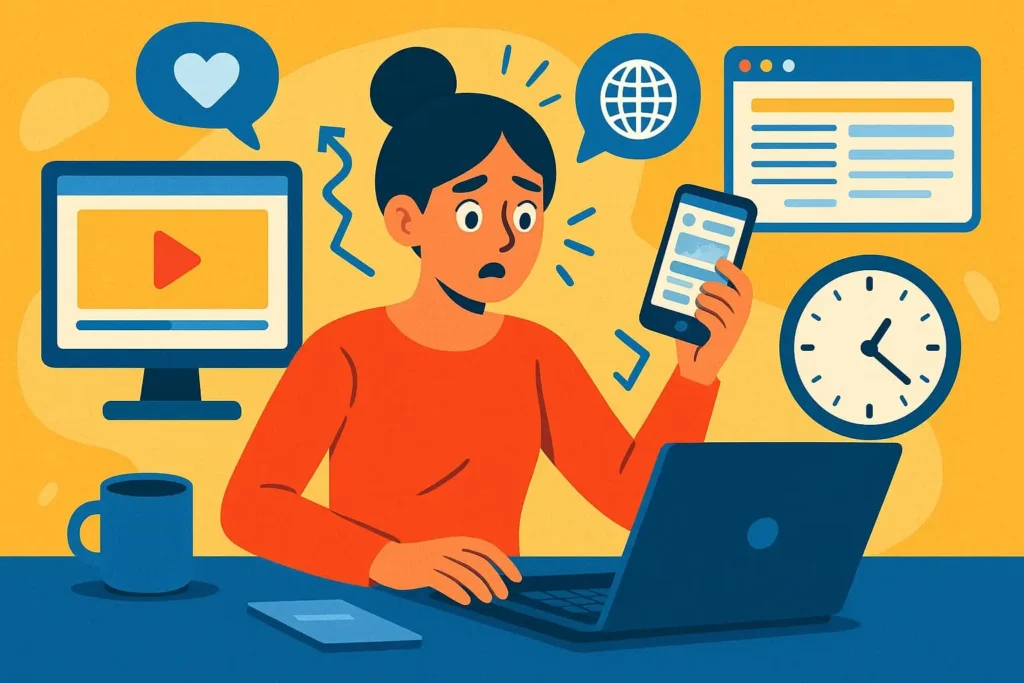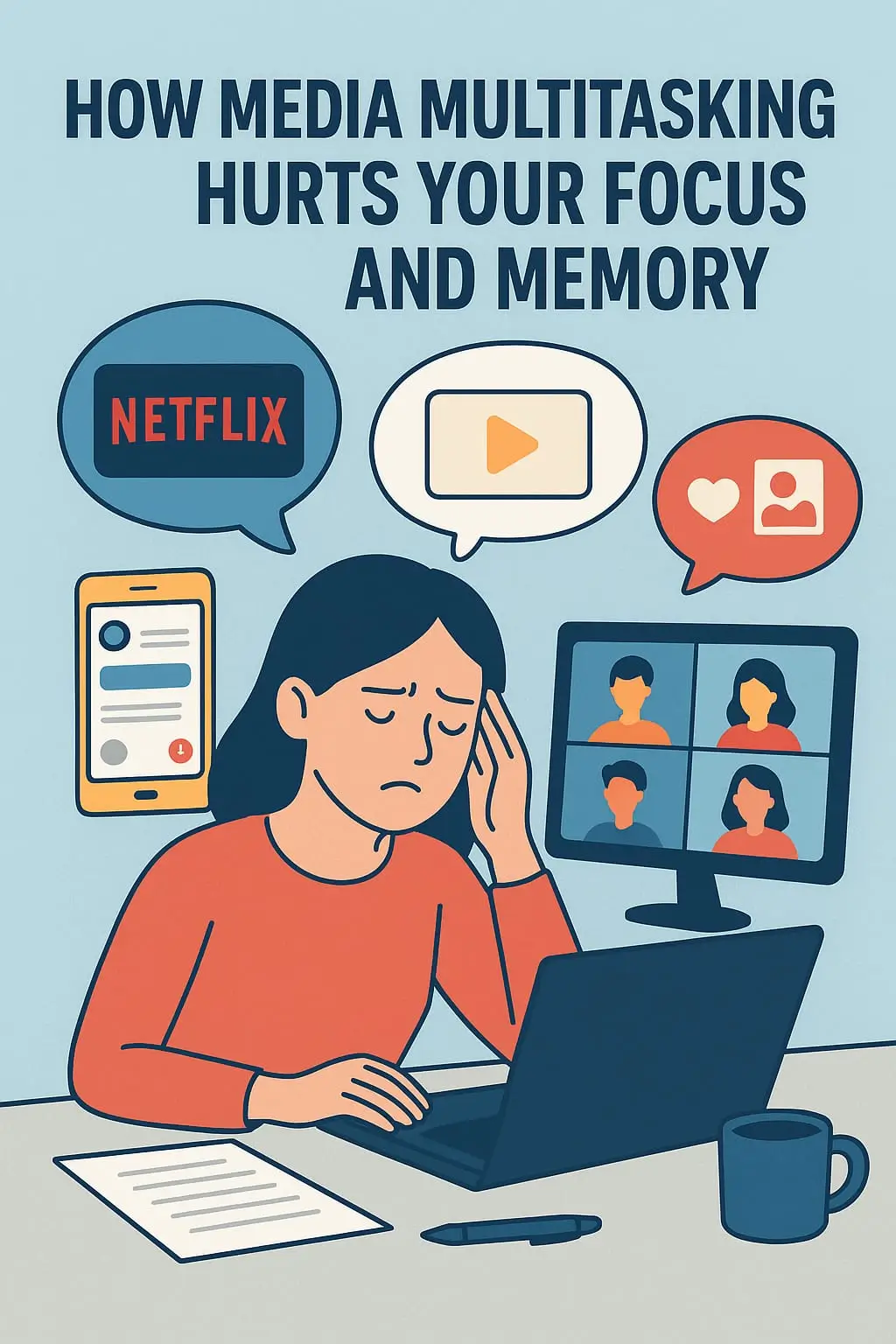Picture this: you’re watching Netflix, scrolling through Instagram, checking your emails, and replying to texts — all at once. It feels productive, right? But here’s the truth — your brain isn’t built for that kind of juggling. We live in a world where doing five things at once feels normal, yet it’s one of the biggest reasons we end up tired, distracted, and forgetful. In today’s world, it’s easy to believe multitasking makes us efficient, but in reality, Media multitasking hurts your focus, memory, and productivity more than it helps. Instead of saving time, you’re training your mind to stay scattered — leaving you mentally drained by the end of the day.
The Multitasking Myth
Most of us believe that juggling tasks helps us get more done. But research says otherwise. What we’re really doing isn’t multitasking — it’s task-switching. Instead of doing more, we end up doing each thing a little less efficiently — and feeling more exhausted in the process. Studies from Stanford University show that only about 2.5% of people can truly multitask effectively. The rest of us are just rapidly switching from one task to another.
What’s Really Going On in Your Brain
1. Your Brain Gets Overloaded
Think of your brain like a computer with too many tabs open. When you try to do several things at once — reply to messages, watch a video, and finish that report — your mental “RAM” fills up fast. You start to lag. Each task gets less of your attention, so you end up making more mistakes and taking longer to finish.
2. Every Switch Costs You Time
Each time you jump from one thing to another, your brain has to pause, switch gears, and get back into the flow. It’s like putting your car in park, changing directions, and then trying to speed up again — over and over. Even a quick glance at your phone can throw off your focus more than you think, and before you know it, those “tiny” interruptions add up to hours lost.
3. Your Memory Starts to Slip
When your attention is scattered, your brain struggles to store information properly. You might read something, nod along, and five minutes later… it’s gone. That’s because multitasking stops you from fully processing what you’re doing — so memories don’t stick as well. Over time, you might notice you forget details more often or have trouble recalling what you just read or heard.
4. Stress Creeps In
Trying to do everything at once might feel productive at first, but it quietly wears you down. Your mind stays in overdrive, jumping from one thing to the next, and that constant switching builds stress and mental fatigue. You end the day feeling drained, even if you didn’t check everything off your list. Eventually, that tension can turn into burnout — that “I just can’t focus anymore” feeling we all know too well.
What Research Says About Media Multitasking
Here’s what science has found again and again:
- A Stanford study showed that heavy media multitaskers perform worse on attention and memory tests.
- The American Psychological Association (APA) found that it can take the brain up to 23 minutes to fully refocus after switching tasks, highlighting the “switching cost” of multitasking.
- Research in PNAS (Proceedings of the National Academy of Sciences) revealed that multitaskers get distracted more easily and take longer to switch tasks.
- A University of California study found that students who studied while checking social media scored lower on tests than those who studied without distractions.
- ScienceDirect Publications showed that constant media multitasking can lead to increased anxiety and mental fatigue.
- Additional studies linked multitasking to poorer emotional well-being and sleep problems.
- One especially concerning experiment showed that watching short, fast-paced videos (like TikTok) while doing a memory task degraded people’s ability to remember intentions later.
Simply put: These studies (and more in the literature) make one thing clear: Media multitasking isn’t harmless. It chips away at your ability to focus, to remember, and to do your best work. The more we multitask with digital media, the less we actually get done — and the more tired our brains become.
The Side Effects You Don’t See Coming
- Takes longer to finish tasks – Every switch adds extra seconds or minutes.
- Shorter attention span – Constant multitasking trains your brain to crave quick hits of stimulation.
- Mental burnout – The more tasks you juggle, the faster you tire out.
And here’s the kicker — many of us believe having “background noise” like TV, podcasts, or music makes us focus better. But studies show that listening to music with lyrics or watching videos while reading actually reduces comprehension and memory. When you try to do too many things at once, your brain reacts as if it’s under constant pressure. Clinically, this can look a lot like temporary ADHD — you get restless, disorganized, and your work quality drops. Inside your brain, something even more interesting happens: it stops using the areas that help you reflect and learn deeply, and instead switches to the ones that just go through the motions.

[For parents, it can also sneak into how kids spend their screen time. Check out the guide on Social Media: The Sneaky Babysitter to see how screen habits affect both focus and attention for children.]
Simple Ways to Escape the Multitasking Trap
Deep Work: The Superpower of Focus
Author Cal Newport calls it deep work — the ability to focus without distraction on a meaningful task. When you practice single-tasking instead of media multitasking, something magical happens:
- You work faster.
- You make fewer mistakes.
- You feel calmer.
- You actually finish what you start.
Here are some practical strategies to help you break free:
1. Time Blocks for Deep Focus
Pick a task and block off 60–90 minutes of uninterrupted time. Treat that block like sacred time. No Slack. No Instagram. Just one task.
2. Notification Lockdown
Turn off unnecessary alerts. Use “Do Not Disturb” or “Focus Mode.” Check messages only at designated times.
3. Single-Task Rituals
Before launching into work, do a mental reset. Close all other tabs. Keep only what you need. Give your brain a clear signal: “This is the one thing I’m doing right now.”
4. Screen-Free Zones
Designate times or spaces (e.g. the first 30 minutes after waking, or on your desk during deep sessions) that are phone-free zones.
5. Schedule Media Time
Instead of randomly doom-scrolling, set aside a 15–20 min block for social media or video breaks. Be intentional about it.
6. Train Focus Like a Muscle
Mindfulness, meditation, or even simple breathing exercises help rewire attention. Over time, your brain becomes more tolerant of boredom and better able to resist distractions.
Try a one-day challenge: Pick one task, turn off all distractions, and give it your full focus. Then come back and tell me — did it make a difference?
Final Thoughts
Media multitasking isn’t a productivity hack — it’s a brain drain. The more we try to do at once, the less we actually achieve. You don’t have to throw out your phone forever or live like a hermit. But by resisting the urge to be everywhere at once, you free your brain to do real, meaningful work.
If you want to feel sharper, calmer, and more productive, give your brain the gift of focus. Turn off the noise, close the extra tabs, and let your mind do what it does best — one thing at a time.
Sources:
- https://news.stanford.edu/stories/2018/10/decade-data-reveals-heavy-multitaskers-reduced-memory-psychologist-says?utm_source
- https://www.apa.org/topics/research/multitasking?utm_source
- https://www.pnas.org/doi/10.1073/pnas.0903620106?utm_source=
- https://www.sciencedirect.com/topics/psychology/media-multitasking?utm_source=
I’d love to hear from you! How do you manage distractions or practice focus in your daily routine? Drop your thoughts in the comments below.
Subscribe and Never Miss a Motivational Boost !!

